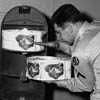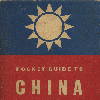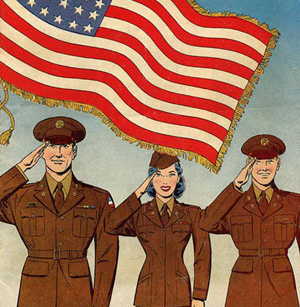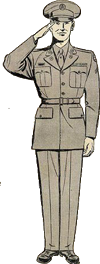Military Courtesy: A Comic For Semi-Literate Soldiers
|
Military Courtesy was a one-shot government produced information comic book for semi-literate military personnel in 1950, not long before the start of the Korean War. The US Army realised the way to reach young recruits was through a comic book, as the only kind of literature many of them read. It tells the story of new recruit Tom, as his commanding officer Corporal Scott guides him through the minefield that is military etiquette. Delivering concise basic information on the dos and don'ts of how to behave in certain situations, it even features a short quiz at the end, for readers to test their knowledge with.
The style and manner of the comic is very dated now, with references to tipping your hat to women as a civilian and Tom being a little surprised that you should salute women who are in the military. In fact nearly all eighteen page comic book are dedicated to the etiquette of saluting! The comic book (officially designated as code FM 21-14) gives details on how to salute, when to salute, whom to salute, as well as other military courtesy. |
|
Military Courtesy wasn't the first or last time that the US Military used comic book to disseminate information among its troops and recruits. Also in 1950, they released Time Of Decision, which encouraged young men entering college to join the ROTC (Reserve Officers Training Corps.) During the same period of the Korean War the Air Force published the USAF Guide to Psychological Warfare (1951), which contained comic book style illustrations. The Navy had a recruitment comic book produced called Dick Wingate of the United States Navy, in 1951. As well as a recruitment comic book for women called Judy Joins The Waves, also in 1951. In the same year famous comic strip character Li'l Abner was recruited in the Navy, with Li'l Abner Joins The Navy! The US Army even turned to comic book artists for their raw recruits basic training manual in 1950, with the publication of a fifty page book entitled You've Had It: The Story Of Basic Training. Though comic books had began to be used as propaganda material as early as WWI, and quite extensively during WWII, the amount of material produced for the US military during the period of the Korean War reflects the impact that comic books were having on the youth culture at large during that period.
|

Psychological Warfare In The Korean War - During the Korean War, the use of leaflet drops as a propaganda tool was huge. An insight into what has since become a sophisticated science.
|

Pocket Guide To China (1942): "How To Spot A Jap" Comic - A piece of WWII propaganda that's so bad, you wonder whether the top-brass were all on drugs when the authorised its release.
|


